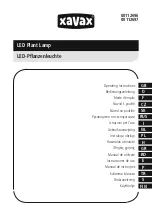20
Rev0.4.1, December 14, 2017
www.seoulsemicon.com
Product Data Sheet
WICOP 2-Outdoor
Precaution for Use
(11) LEDs are sensitive to Electro-Static Discharge (ESD) and Electrical Over Stress (EOS).
Below is a list of suggestions that Seoul Semiconductor purposes to minimize these effects.
a. ESD (Electro Static Discharge)
Electrostatic discharge (ESD) is the defined as the release of static electricity when two objects
come into contact. While most ESD events are considered harmless, it can be an expensive
problem in many industrial environments during production and storage. The damage from ESD
to an LEDs may cause the product to demonstrate unusual characteristics such as:
- Increase in reverse leakage current lowered turn-on voltage
- Abnormal emissions from the LED at low current
The following recommendations are suggested to help minimize the potential for an ESD event:
One or more recommended work area suggestions:
- Ionizing fan setup
- ESD table/shelf mat made of conductive materials
- ESD safe storage containers
One or more personnel suggestion options:
- Antistatic wrist-strap
- Antistatic material shoes
- Antistatic clothes
Environmental controls
- Humidity control (ESD gets worse in a dry environment)
b. EOS (Electrical Over Stress)
Electrical Over-Stress (EOS) is defined as damage that may occur when an electronic device is
subjected to a current or voltage that is beyond the maximum specification limits of the device.
The effects from an EOS event can be noticed through product performance like:
Changes to the performance of the LED package (If the damage is around the bond pad area and
since the package is completely encapsulated the package may turn on but flicker show severe
performance degradation.)
Changes to the light output of the luminaire from component failure
Components on the board not operating at determined drive power
Failure of performance from entire fixture due to changes in circuit voltage and current across
total circuit causing trickle down failures
It is impossible to predict the failure mode of every LED exposed to electrical overstress as the
failure modes have been investigated to vary, but there are some common signs that will indicate
an EOS event has occurred.
- Damaged may be noticed to the bond wires (appearing similar to a blown fuse).
- Damage to the bond pads located on the emission surface of the LED package
(shadowing can be noticed around the bond pads while viewing through a microscope).
- Anomalies noticed in the encapsulation and phosphor around the bond wires.
- This damage usually appears due to the thermal stress produced during the EOS event.
c. To help minimize the damage from an EOS event Seoul Semiconductor recommends utilizing
- qualified LED driver with no big over shoot out put
- Isolated driver that to prevent harmful peaks passed to module.
- A current limiting device


















